Zhijian Zhou
Youtu-Agent: Scaling Agent Productivity with Automated Generation and Hybrid Policy Optimization
Dec 31, 2025Abstract:Existing Large Language Model (LLM) agent frameworks face two significant challenges: high configuration costs and static capabilities. Building a high-quality agent often requires extensive manual effort in tool integration and prompt engineering, while deployed agents struggle to adapt to dynamic environments without expensive fine-tuning. To address these issues, we propose \textbf{Youtu-Agent}, a modular framework designed for the automated generation and continuous evolution of LLM agents. Youtu-Agent features a structured configuration system that decouples execution environments, toolkits, and context management, enabling flexible reuse and automated synthesis. We introduce two generation paradigms: a \textbf{Workflow} mode for standard tasks and a \textbf{Meta-Agent} mode for complex, non-standard requirements, capable of automatically generating tool code, prompts, and configurations. Furthermore, Youtu-Agent establishes a hybrid policy optimization system: (1) an \textbf{Agent Practice} module that enables agents to accumulate experience and improve performance through in-context optimization without parameter updates; and (2) an \textbf{Agent RL} module that integrates with distributed training frameworks to enable scalable and stable reinforcement learning of any Youtu-Agents in an end-to-end, large-scale manner. Experiments demonstrate that Youtu-Agent achieves state-of-the-art performance on WebWalkerQA (71.47\%) and GAIA (72.8\%) using open-weight models. Our automated generation pipeline achieves over 81\% tool synthesis success rate, while the Practice module improves performance on AIME 2024/2025 by +2.7\% and +5.4\% respectively. Moreover, our Agent RL training achieves 40\% speedup with steady performance improvement on 7B LLMs, enhancing coding/reasoning and searching capabilities respectively up to 35\% and 21\% on Maths and general/multi-hop QA benchmarks.
The Choice of Divergence: A Neglected Key to Mitigating Diversity Collapse in Reinforcement Learning with Verifiable Reward
Sep 09, 2025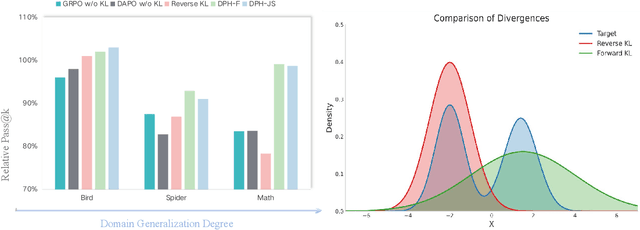
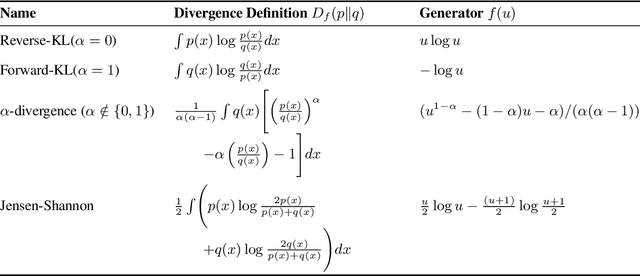
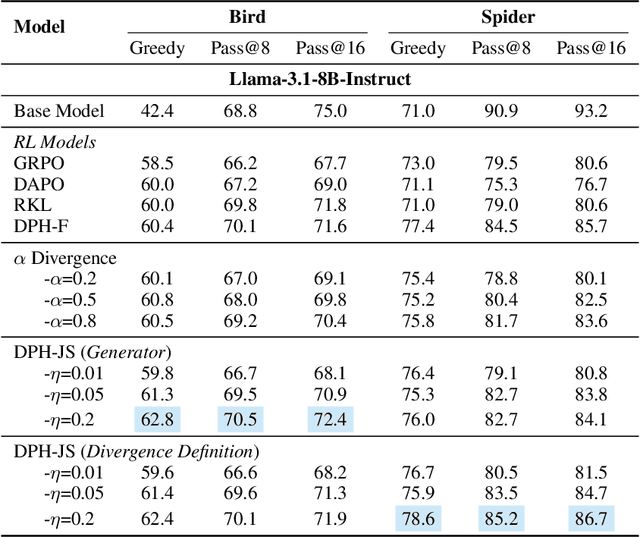
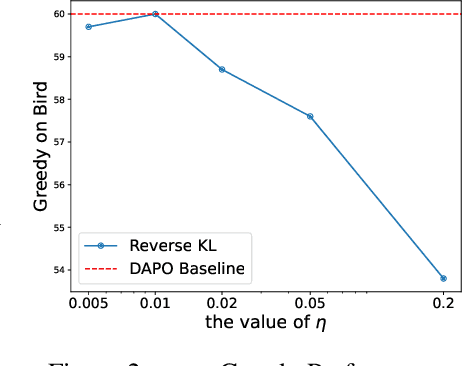
Abstract:A central paradox in fine-tuning Large Language Models (LLMs) with Reinforcement Learning with Verifiable Reward (RLVR) is the frequent degradation of multi-attempt performance (Pass@k) despite improvements in single-attempt accuracy (Pass@1). This is often accompanied by catastrophic forgetting, where models lose previously acquired skills. While various methods have been proposed, the choice and function of the divergence term have been surprisingly unexamined as a proactive solution. We argue that standard RLVR objectives -- both those using the mode-seeking reverse KL-divergence and those forgoing a divergence term entirely -- lack a crucial mechanism for knowledge retention. The reverse-KL actively accelerates this decay by narrowing the policy, while its absence provides no safeguard against the model drifting from its diverse knowledge base. We propose a fundamental shift in perspective: using the divergence term itself as the solution. Our framework, Diversity-Preserving Hybrid RL (DPH-RL), leverages mass-covering f-divergences (like forward-KL and JS-divergence) to function as a rehearsal mechanism. By continuously referencing the initial policy, this approach forces the model to maintain broad solution coverage. Extensive experiments on math and SQL generation demonstrate that DPH-RL not only resolves the Pass@k degradation but improves both Pass@1 and Pass@k in- and out-of-domain. Additionally, DPH-RL is more training-efficient because it computes f-divergence using generator functions, requiring only sampling from the initial policy and no online reference model. Our work highlights a crucial, overlooked axis for improving RLVR, demonstrating that the proper selection of a divergence measure is a powerful tool for building more general and diverse reasoning models.
SDPO: Importance-Sampled Direct Preference Optimization for Stable Diffusion Training
May 28, 2025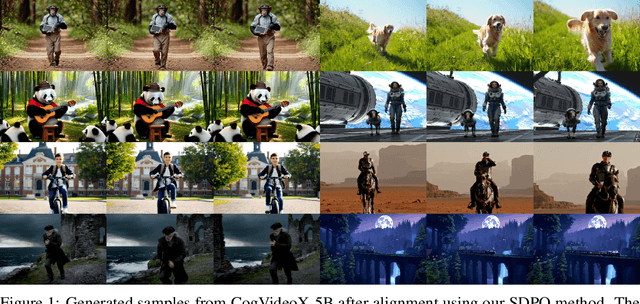

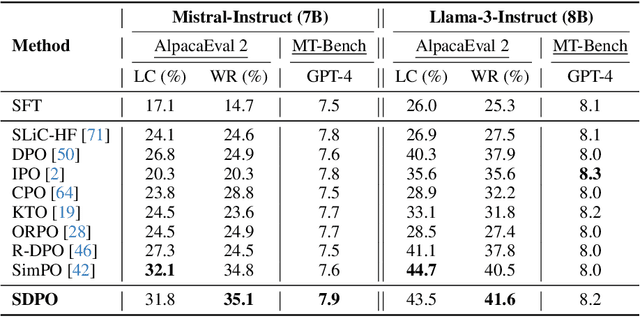
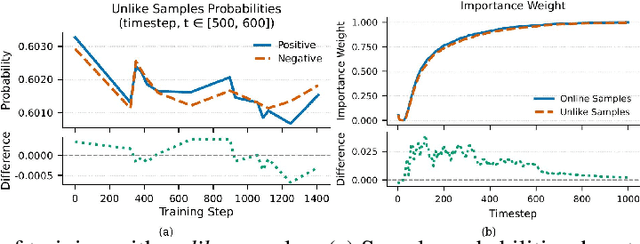
Abstract:Preference learning has become a central technique for aligning generative models with human expectations. Recently, it has been extended to diffusion models through methods like Direct Preference Optimization (DPO). However, existing approaches such as Diffusion-DPO suffer from two key challenges: timestep-dependent instability, caused by a mismatch between the reverse and forward diffusion processes and by high gradient variance in early noisy timesteps, and off-policy bias arising from the mismatch between optimization and data collection policies. We begin by analyzing the reverse diffusion trajectory and observe that instability primarily occurs at early timesteps with low importance weights. To address these issues, we first propose DPO-C\&M, a practical strategy that improves stability by clipping and masking uninformative timesteps while partially mitigating off-policy bias. Building on this, we introduce SDPO (Importance-Sampled Direct Preference Optimization), a principled framework that incorporates importance sampling into the objective to fully correct for off-policy bias and emphasize informative updates during the diffusion process. Experiments on CogVideoX-2B, CogVideoX-5B, and Wan2.1-1.3B demonstrate that both methods outperform standard Diffusion-DPO, with SDPO achieving superior VBench scores, human preference alignment, and training robustness. These results highlight the importance of timestep-aware, distribution-corrected optimization in diffusion-based preference learning.
ChemHAS: Hierarchical Agent Stacking for Enhancing Chemistry Tools
May 27, 2025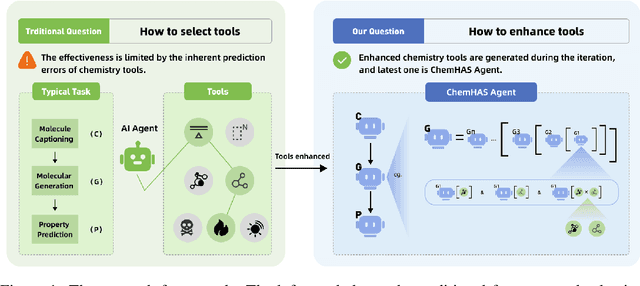
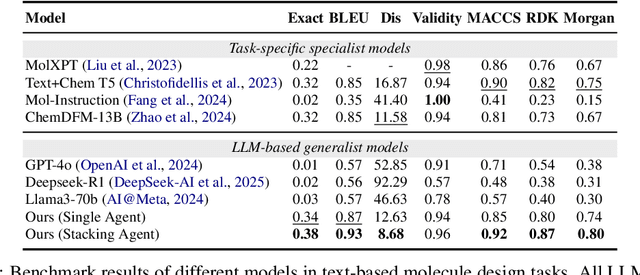
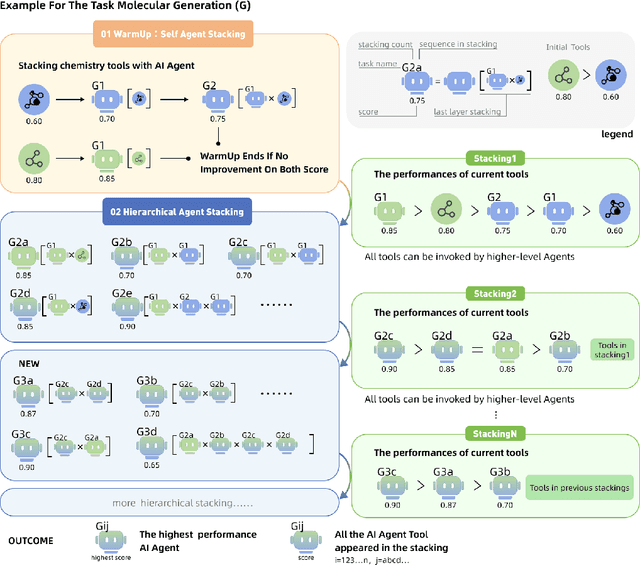
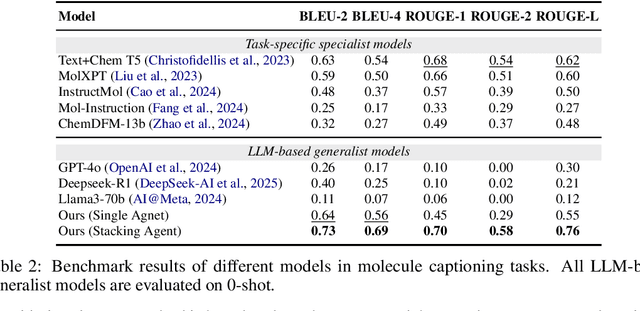
Abstract:Large Language Model (LLM)-based agents have demonstrated the ability to improve performance in chemistry-related tasks by selecting appropriate tools. However, their effectiveness remains limited by the inherent prediction errors of chemistry tools. In this paper, we take a step further by exploring how LLMbased agents can, in turn, be leveraged to reduce prediction errors of the tools. To this end, we propose ChemHAS (Chemical Hierarchical Agent Stacking), a simple yet effective method that enhances chemistry tools through optimizing agent-stacking structures from limited data. ChemHAS achieves state-of-the-art performance across four fundamental chemistry tasks, demonstrating that our method can effectively compensate for prediction errors of the tools. Furthermore, we identify and characterize four distinct agent-stacking behaviors, potentially improving interpretability and revealing new possibilities for AI agent applications in scientific research. Our code and dataset are publicly available at https: //anonymous.4open.science/r/ChemHAS-01E4/README.md.
Revisit Non-parametric Two-sample Testing as a Semi-supervised Learning Problem
Nov 30, 2024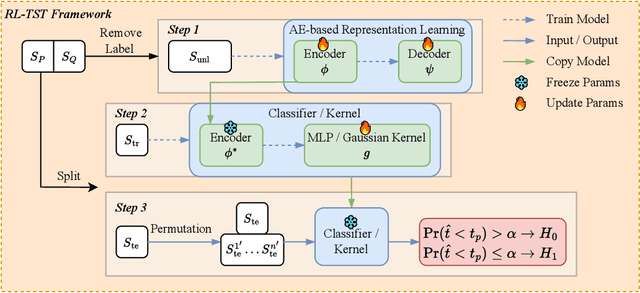



Abstract:Learning effective data representations is crucial in answering if two samples X and Y are from the same distribution (a.k.a. the non-parametric two-sample testing problem), which can be categorized into: i) learning discriminative representations (DRs) that distinguish between two samples in a supervised-learning paradigm, and ii) learning inherent representations (IRs) focusing on data's inherent features in an unsupervised-learning paradigm. However, both paradigms have issues: learning DRs reduces the data points available for the two-sample testing phase, and learning purely IRs misses discriminative cues. To mitigate both issues, we propose a novel perspective to consider non-parametric two-sample testing as a semi-supervised learning (SSL) problem, introducing the SSL-based Classifier Two-Sample Test (SSL-C2ST) framework. While a straightforward implementation of SSL-C2ST might directly use existing state-of-the-art (SOTA) SSL methods to train a classifier with labeled data (with sample indexes X or Y) and unlabeled data (the remaining ones in the two samples), conventional two-sample testing data often exhibits substantial overlap between samples and violates SSL methods' assumptions, resulting in low test power. Therefore, we propose a two-step approach: first, learn IRs using all data, then fine-tune IRs with only labelled data to learn DRs, which can both utilize information from whole dataset and adapt the discriminative power to the given data. Extensive experiments and theoretical analysis demonstrate that SSL-C2ST outperforms traditional C2ST by effectively leveraging unlabeled data. We also offer a stronger empirically designed test achieving the SOTA performance in many two-sample testing datasets.
 Add to Chrome
Add to Chrome Add to Firefox
Add to Firefox Add to Edge
Add to Edge